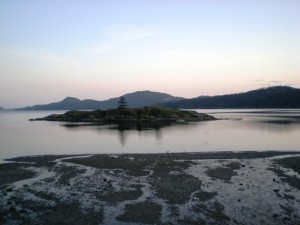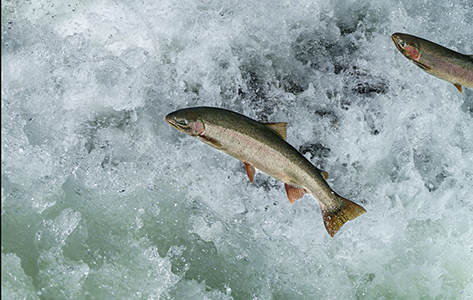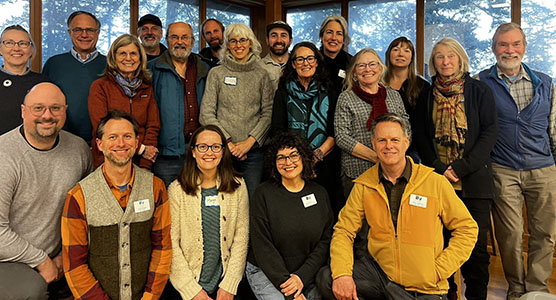Center for the Historical Ecology of the Salish Sea Leads Partnership for Students and Amateur Scientists
This Thursday, April 29, volunteers in a partnership of those who appreciate and steward marine life, under the leadership of Kwiáht — the Center for the Historical Ecology of the Salish Sea — will welcome the public to participate in the Indian Island Marine Health Observatory.
Indian Island, a low-tide’s walk from the village of Eastsound, is the first of three sites that will become invaluable marine science observatories in the San Juan Islands. Indian Island is the initial observatory, with plans for similar studies to be conducted at the Friday Harbor Marina on San Juan Island and Fisherman’s Bay on Lopez Island.
Indian Island Marine Health Observatory is not a building, but a research project in which the public, students and scientists participate. Observatory partners will teach stewardship, research methods and an appreciation of the marine diversity on the East Sound beach. This evaluation of Indian Island bio-diversity was started by Russell Barsh, founder of Kwiáht. In the Coast Salish language of Puget Sound, “Kwiáht” means “a spiritually clean place.” Kwiáht’s Articles define its twofold mission as:
- scientific research in the service of good stewardship of cultural and biological resources in the San Juan and Gulf Islands,
- the improvement of local science education
Other organizations participating in the Indian Island Marine Health Observatory are the Washington State University (WSU) Extension Beach Watchers, San Juan Nature Institute, U.S. Bureau of Land Management, San Juan County Land Bank, San Juan County Parks, Orcas Island School District, Salmonberry School and Orcas Christian School.
The Indian Island Observatory volunteer stewards plan many research and outreach event days this spring and summer, to explain the marine observations and mysteries that are apparent at low tides on:
- April 29
- May 16
- May 28
- June 13
- June 26
- July 12
- Aug. 9
“These [marine observatories] are places where we take the pulse of human impact on the marine environment,” says Barsh, founder of Kwiáht. “The areas are directly impacted by cars, stormwater runoff, built-up structures, chemical and sewage outflow.”
The Bureau of Land Management, which owns Indian Island, had contacted Beach Watchers about monitoring human traffic and learn about its marine environment. The project was undertaken by the San Juan Nature Institute with the participation of Fiona Norris, the Nature Institute’s Science Director, and of Salmonberry School. Barsh asked why the study should be limited to human traffic, when Indian Island and the East Sound tidal area “could make a resource for all Eastsound schools in a systematic way.”
The Indian Island Marine Observatory then became the template for similar studies on Lopez and San Juan Islands, with classes, outreach and research. “It’s a community enterprise in a broad sense,” says Barsh; “That’s why it was included in the Visitors’ Guide to the islands; ideally, it will add to tourists’ and visitors’ appreciation of this place.”
Orcas Islander Barbara Bentley, a retired university professor of biology and ecology, with a strong background in environmental research, is the project manager. This past winter she has organized the volunteers, including this year’s class of Beach Watchers, in a way that’s most effective for carrying out the project’s priorities:
- Training the volunteers to directly assist with research and data collection, such as setting up transects, seining for fish and night collections
- Educating the public as to what the volunteers are doing and the value of the local eco-system
- Developing written materials about the project and why it is being undertaken
At the low-tide events this weekend, Apr. 29 to May 1, there will be specific research activities, including a public walk. Brochures will be available at local stores, real estate agencies and the library, and the bookmarks describing beach walk “etiquette” will be distributed.
Bentley says, “Indian Island is a spectacular island for these research and outreach activities, especially given that it’s right here. It’s also incredibly vulnerable.”
Barsh invites both interested scientists and the casual passers-by to “chip in” during the weekend’s activities, and those at every low tide. “When the tide is low, and they see us on the beach, they’re welcome to help out. There will be temporary signboards on the beach and at the County Waterfront Park to tell people we’re out there and what we’re doing that day.”
Observation plans include installing an interpretive panel by the storm sewer outlet, on the beach across from the Outlook Inn, and also creating a permanent exhibit at the Funhouse where visitors can see pictures and videos of the marine observatory.
Barsh says, “Right now, the two big concerns are:
- collecting the second full year of data to compare to 2009’s observations
- outreach to the business community to develop a conversation about changes in the environment caused by contamination
“We want this to be a collaborative effort in conversation with everyone who works here in town from the start,” says Barsh. “It’s curious – I thought the [East Sound] bay was really dead. But we’re seeing so much life in the bay, it should be seen as an awesome asset that should be protected.”
Marcia Spees, a graduate of the Beach Watchers Class last year, says that scientific research may seem too obscure to the public, but “people can be involved and understand the environment. Through the Indian Island Marine Health Observatory, participating organizations share their scientific knowledge with the layman, rather than establish some ‘uber-ego’ authority,” Spees says.
Part of the Beach Watchers education is a commitment to match the 100 hours of training in marine ecology with 100 hours of service to the community, given over two years. Spees “fell in love with the Indian Island project and its opportunities for hands-on field research. The marine environment in East Sound is a secret world, full of wonder. Its diversity of life blows my mind.”
Some of the outreach will be conducted in beach walks where the layman can participate with volunteer scientists to study the shore environment. Beach seines will “capture” marine life that is identified and categorized, eelgrass is measured, buoys with light sensors reveal the timing and density of algal blooms, plankton is monitored and pollution is observed and measured.
A database of the species that are most sensitive to stress – the “canaries in the coal mine” – will be created. Kwiáht will work with teams at Indian Island, and also with the planned projects on Lopez and San Juan Islands, to review what’s changing at each location and what habitats and species may be endangered or at risk.
Overall, the outreach is planned to analyze the effects of human near-shore population, teaching people about environmental impacts and establishing a data base to catalog the research findings, Barsh says.
Barsh adds that Indian Island research assists San Juan County officials who are endeavoring to comply with state stormwater mandates. “The Indian Island program will inspire more direct, transparent conversation on how to keep stormwater under control…. with fairly low-tech solutions that will be cheaper and more effective than building a big treatment plant.”
“We have a de facto county-wide marine monitoring system with a network to answer questions the county’s Marine Resource Committee keeps asking. We don’t need consultants from Seattle, we have community volunteers and stewards to do the work so that the next time a storm sewer or road is planned, the citizens can inform the county on the basis of their date, knowledge and research.
“County environmental employees are so relieved there will be some data instead of conjecture. We can show that people on the island are doing research and will be taken seriously. It’s about science and about politics in the best sense, and about empowering people through knowledge.”
More information about the Indian Island Marine Observatory is available at www.indianisland.info
**If you are reading theOrcasonian for free, thank your fellow islanders. If you would like to support theOrcasonian CLICK HERE to set your modestly-priced, voluntary subscription. Otherwise, no worries; we’re happy to share with you.**










[…] first of three Marine Health Observatories in the San Juan Islands. There is important ongoing research being conducted there by scientists and volunteers. We’re fortunate to be able to enjoy its […]